The Benefits Of Pet Ownership In Childhood Development

Introduction
Have you ever seen the way a child's face lights up when greeted by the wagging tail from a family dog or a cat's gentle purr? The bond between children and their pets is something extraordinary. Beyond unconditional love and companionship, studies show that pet ownership can have a significant positive influence on child development.
From building confidence and empathy to reducing stress and encouraging physical activity, pets teach important life lessons and cultivate essential skills. This comprehensive guide explores the many benefits of pet ownership and how it contributes to well-rounded human development right from early childhood.
This guide has been divided into four main chapters, addressing different aspects of pet ownership and what it means for kids' development. It also highlights useful tips for parents and kids to interact with pets and get the best out of human-animal relationships. So, let's get started!
Chapter One: Understanding The Appeal Of Pets
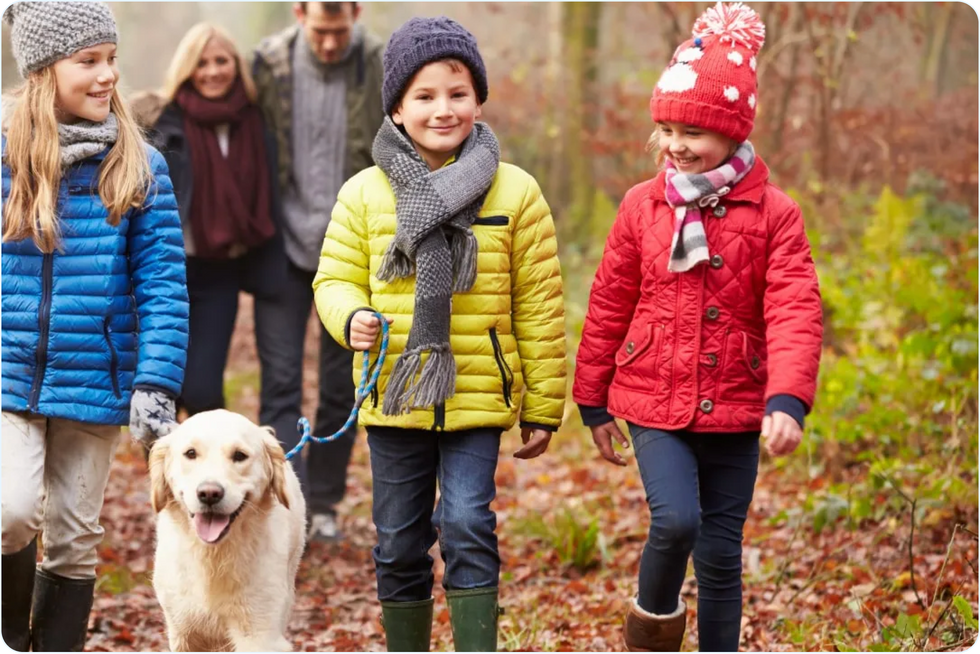
This chapter explores the appeal of pets in modern societies, providing statistics on pet ownership in US homes. It also looks into the different reasons people choose to have pets and digs into the long history of people keeping pets.
You'll learn about the most common pets people have, from dogs and cats to fish and birds, and better understand the care and responsibility needed to ensure that pets are happy and healthy.
Pets have played a central role in comforting Americans during the COVID-19 pandemic"
Steve King
President and CEO of APPA

Why do people choose to have pets?
From companionship to fulfilling a family's desire, the reasons people welcome a pet into their lives are many. This section will explore why the popularity of pet ownership has been steadily increasing, the motivations behind this phenomenon, and its fascinating history.
- US pet ownership has soared in recent years, with 66% of households now welcoming furry companions, according to a 2023-2024 survey by the American Pet Products Association (APPA).
- Pets provide a sense of belonging and unconditional love. Their presence can combat loneliness, especially during challenging times.
- Often, the decision to get a pet stems from a shared desire within the family, particularly when children are involved. Pets offer valuable life lessons and a sense of togetherness for families.
- Many compassionate people choose to adopt a pet to provide a loving and safe environment for an animal in need.
- Research shows that pet ownership can offer significant mental health benefits. Pets help reduce stress and anxiety, and they offer emotional support.
- The bond between humans and animals dates back thousands of years. Historical evidence and records depict a long-standing tradition of cherishing animal companions.
Nowadays Pets Are Well And Truly Much-Loved Additions.
60%
allowed their pet to sleep in bed with them
54%
buy gifts for their furry (or feathered) friends during the holiday season
In terms of why these generous pet owners got their pets in the first place, many actually did so (36%) because their partner or other family members wanted one. Parents of children under 18 are even more likely (47%) to say this is why they got a pet. The benefits a pet can bring a family is a strong driving force. Reasons included:
36%
because their partner or other family members wanted one
52%
of pet owners say they got a pet to keep them company
49%
decided to get a pet because they thought they could provide a nice home
40%
got a pet in the hope of improving their own mental health
What are the most common types of pets owned by people?
Pets have been companions to humans for thousands of years, fulfilling various roles in households and communities. Over time, the variety of animals kept as pets has expanded, reflecting changes in society, lifestyles, and preferences.
However, some animals have remained particularly popular choices. Here are the most common types of pets owned by people, according to the American Pet Products Association (APPA):
Dogs
Dogs are the most commonly owned pet in the US, with an estimated 65.1 million households owning a dog according to a 2023-2024 survey. Often referred to as "man's best friend", dogs are renowned for their loyalty, companionship, and versatility.
They come in a vast range of breeds, each with its unique traits, making them suitable for various lifestyles and preferences.
Dogs are highly social animals that can integrate well into human families. They require regular exercise, mental stimulation, and social interaction. Different breeds have distinct care needs, temperaments, and energy levels.
Cats
Cats are also really popular, with about 46.5 million households owning at least one cat according to a 2023-2024 survey. They are cherished for their independent nature and ease of care, making them ideal pets for individuals with busy lifestyles.
They are known for their agility, playful behavior, and affectionate yet self-reliant temperament. Cats typically require less space and can thrive in indoor environments. They are natural hunters and can provide pest control.
Fish
Fish are the third most popular pet in the U.S., with around 11.1 million households having an aquarium. Freshwater fish are more common than saltwater species, largely due to the ease of maintaining freshwater aquariums.
Fish are a popular choice for those who appreciate the serene beauty of aquatic life and are looking for a relatively low-maintenance pet. They come in countless species, offering a vast array of colors, sizes, and habitat needs.
Keeping fish can be a calming hobby, with the maintenance of the aquarium offering a sense of tranquility and satisfaction. Fish require specific water conditions to thrive, including temperature, pH levels, and cleanliness.
Birds
Approximately 6.1 million households in the US own a bird. Birds are appreciated for their intelligence, social nature, and the beauty they bring into a home. They also add vibrancy and music to households with their colorful plumage and melodious songs. Popular bird pets include parrots, canaries, and finches.
They are intelligent and can form strong bonds with their owners. Many birds also have the capacity for speech or mimicry, adding a unique interactive element. Birds typically require mental stimulation, social interaction, and space to fly within their cages or aviaries.
Small mammals
This category includes rabbits, guinea pigs, hamsters, and ferrets, which are often favored for their size and the lower level of care they require compared to larger pets.
Around 6.7 million US households own small mammals. They can be playful and affectionate, making them suitable companions. They require less space and are often suitable for various living situations, including apartments.
Care needs vary widely among different types of small mammals, with some needing more social interaction and space to roam.
All in all, each type of pet offers its own unique set of benefits and challenges. The best choice depends on a person's lifestyle, preferences, and ability to meet the needs of the pet they choose to bring into their home.
Chapter Two: Effects Of Pet Ownership On Children's Development

Having pets around the home helps kids in lots of ways. Pets teach kids about making friends, caring for others, and even feeling better emotionally. Pets can also make kids better able to engage in conversations, make new friends, and give them a big confidence boost.
Pets are like personal cheerleaders, making kids feel loved and important, which is awesome for their mood. Also, running around and playing with pets is a fun way to keep kids fit and healthy.
And let’s not forget, that taking care of a pet teaches kids to be responsible; feeding, walking, and cleaning up after a pet shows them how to stick to tasks. Essentially, this chapter is all about how pets help kids grow up happier, healthier, and smarter.
The Positive Influence Of Pets On Social Skills
Having a furry family member offers unique opportunities for children to develop strong social skills. Here's how pets help kids flourish:
- Caring for a pet involves giving instructions, understanding nonverbal cues, and responding to their needs, fostering better communication skills.
- Pets act as natural icebreakers, helping shy children connect with others, form new friendships, and gain confidence in social settings.
- Animals are wonderful listeners. They don't interrupt or judge, which can make kids feel comfortable practicing reading to them or sharing secrets. This builds confidence and helps kids open up better.
- A child-pet relationship can foster empathy, responsibility, and emotional intelligence in children as they learn to care for and understand their animal companions.
This can be beneficial while learning too. Mary Renck Jalongo, PhD, education professor at Indiana University of Pennsylvania and author of 'The World Of Children And Their Companion Animal' spoke about a study during which children were asked to read in front of a peer, an adult, and a dog while researchers monitored their stress levels. The audience they were most relaxed around was the dogs.
Boosting Emotional Well-Being With Pet Companions
Companion animals offer unwavering affection, acceptance, and a listening ear for children. They are sources of comfort and support, especially during difficult times. Pet ownership positively impacts emotional development in the following ways:- Family pets can provide a sense of comfort, security, and unconditional love, which can help children cope better with stress and anxiety.
- Caring for a pet gives children a sense of responsibility and accomplishment. Feeling loved unconditionally by an animal boosts their confidence and self-esteem.
- Pets provide companionship, especially for children without siblings or those struggling socially. Their presence offers comfort and eases feelings of isolation.
- Pet ownership can teach children valuable life lessons about commitment, loss, and grief, preparing them for future emotional challenges.
- Pets bring everyone together! Caring for a furry family member, playing together, and sharing stories about their funny antics leads to precious shared experiences and strengthens family connections.
Kids often see their pets as friends, confiding in them and relying on them for comfort. Dogs are particularly good at this, says Dr. Ann Berger, a physician and researcher at the NIH Clinical Center in Bethesda, Maryland.
“The foundations of mindfulness include attention, intention, compassion, and awareness,” Berger says. “All of those things are things that animals bring to the table. People kind of have to learn it. Animals do this innately.” Their attention is focused on who they’re with most of the time.
Their unconditional love can do more than keep a child company; interacting with animals has been shown to decrease levels of cortisol (a stress-related hormone), increase the release of dopamine and oxytocin, which are anti-stress or feel-good hormones, and lower blood pressure.
The 'social' support given by pets has some advantages compared to the social support given by humans. Pets can make people feel unconditionally accepted, whereas fellow humans will judge and may criticize"
Nienke Endenburg and Ben Baarda
The Waltham Book of Human-Animal Interaction

Learning Responsibility Through Pet Care
Caring for a furry family member is a valuable way for children to learn about responsibility. With age-appropriate tasks, kids develop a greater sense of discipline and maturity.
- Remembering to feed a pet or take them for walks teaches children about consistency and the importance of fulfilling commitments.
- Tasks like bathing and brushing a pet develop a sense of responsibility and encourage good hygiene practices.
Gail F. Melson, PhD, professor emeritus of developmental studies at Purdue University, in Indiana, and the author of 'Why The Wild Things Are: Animals In The Lives Of Children' said: “nurturing isn't a quality that suddenly appears in adulthood when we need it… People need a way to practice being caregivers when they're young."
And pets offer just that opportunity. She researched how much time kids over three spent actively caring for their pets versus caring for or even playing with younger siblings. She found that within a 24-hour period:
- Kids with pets spent 10.3 minutes in caregiving
- Kids with only younger siblings spent only 2.4 minutes
Nurturing isn't a quality that suddenly appears in adulthood when we need it… People need a way to practice being caregivers when they're young"
Gail F. Melson, PhD
Professor emeritus of developmental studies
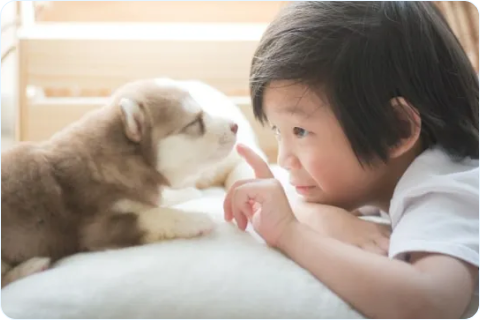
Pets And Physical Health: More Than Just Playtime
Pet ownership encourages a healthier lifestyle for both children and families. They can contribute significantly to physical activity and overall health outcomes.
- Dog ownership has been associated with increased physical activity and reduced risk of obesity in children, contributing to better overall health. Dogs, especially, require regular walks and playtime, ensuring children get enough physical activity.
- Playing fetch in the yard, exploring nature trails with dogs, and caring for pets motivate kids to spend more time outdoors.
- Growing up with pets may reduce the risk of developing allergies and asthma, as early exposure to pet dander can help build a child's immune system.
- The global health benefits of pet ownership extend beyond physical health, as pets can contribute to improved mental well-being and a sense of purpose in children's lives.
According to a study by Dennis Ownby , MD, a pediatrician and head of the allergy and immunology department of the Medical College of Georgia, having multiple pets decreases a child's risk of developing certain allergies.
He tracked 474 babies from birth to about age 7, discovering that children who were exposed to two or more dogs or cats as babies were less than half as likely to develop common allergies as kids who had no pets in the home. Kids with pets had fewer positive skin tests to both:
- Indoor allergens, such as pet and dust-mite allergens
- Outdoor allergens, such as ragweed and grass
Having multiple pets decreases a child's risk of developing certain allergies.
According to a study by Dennis Ownby, M.D.

Tips For Human-Animal Interaction And Responsible Pet Ownership
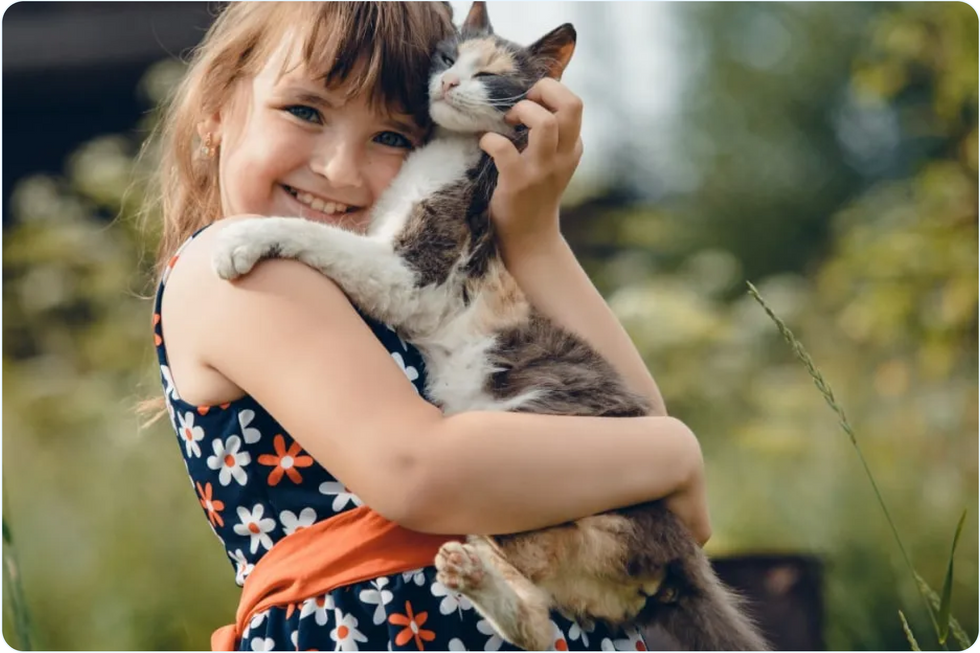
Playtime with pets is fun, builds strong connections, and assists children's development. But like humans, pets have feelings and sometimes need their space. Learning how to play responsibly and recognize signs of stress or discomfort helps both kids and cuddly companions have the best experience together.
Just like people, animals show clues about how they're feeling. Pet owners need to look out for these signs to ensure your pet is comfortable and happy:

Dogs
- A tail tucked under may mean a dog is anxious
- If a dog is panting (without exercise), they may be experiencing stress
- Showing teeth or growling is a warning sign that a dog needs space
- Yawning, drooling, and licking can mean a dog is nervous
- Dogs may pace or find it hard to settle if they are agitated
- A dog may cower or shrink if it feels threatened

Cats
- Hiding or escape behavior
- Crouching and looking tense, especially close to the ground, may mean the cat is frightened
- Hissing or growling is a warning sign that a cat needs space
- Cats may demonstrate exaggerated swallowing or licking their nose if scared
- Repeated pacing when in the home, often accompanied by loud meowing, is likely a sign of stress
- Scratching excessively on the furniture

Small Animals
- Running away or trying to get away
- Small animals with dilated pupils, blinking rapidly and generally having a startled appearance are scared
- Scared small animals may also jump at every sudden sound or movement and always be on high alert
- Rabbits may hold their ears back tight against their head or thump the ground if they’re stressed
- Repetitive behaviors, such as circling or biting the bars of their cage, could mean an animal is stressed
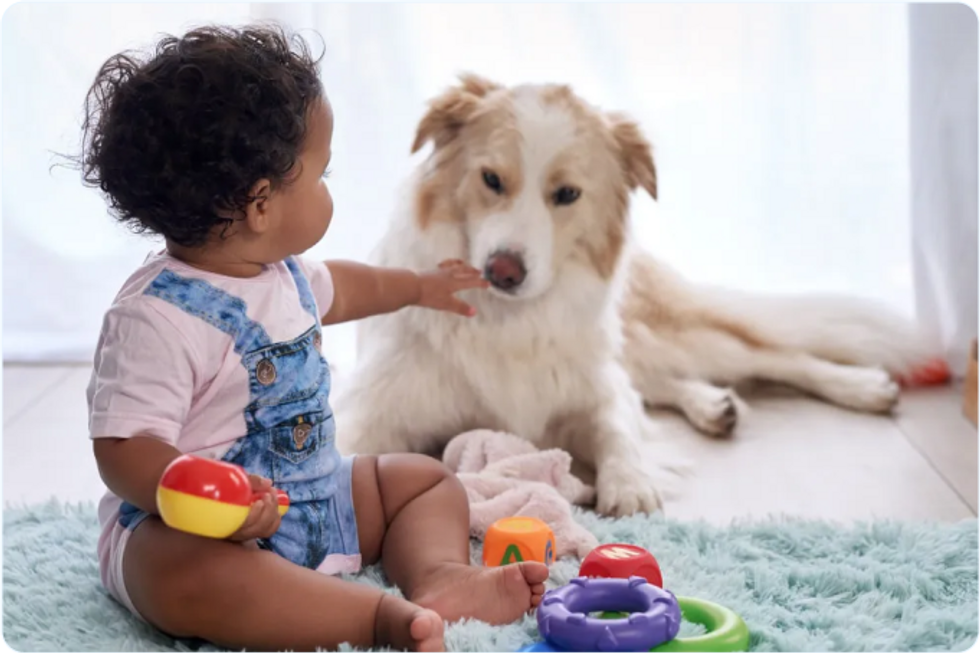
Pets can be sensitive. They can easily become anxious or frustrated by things going on around them, or by the way people interact with them, especially if it’s a new or unknown experience. As a pet owner, you’re responsible for creating safe, comfortable environments for them.
Throughout this guide, we have mainly focused on adding a pet to a home with children. But it often happens the other way around, a new baby arrives after a pet.
From your pet’s perspective, this will be a huge change and potential disruption. It’s one of the biggest changes that could happen to them – think about the new sounds and smells, the arrival of new furniture and objects, and the changes to your routine.
It can cause stress, but once again, understanding your pet and knowing what’s normal or isn’t will help ease any transition, whether it’s during playtime or another family event.
Other tips for parents wanting to encourage responsible play are:
- Model the right behavior yourself. You can set the right example yourself by interacting with your pets in a responsible, safe way.
- Getting kids involved in training. Training your pet doesn’t have to be boring. You can get children involved and show them what to do to teach your pet a new trick.
- Reinforce positive behaviors from both pet and child. Always remember to encourage the right behaviors with praise.
- Be present when they’re playing. It’s always best to supervise close contact between your children and pets, especially when they’re young or new to one another. Both animals and kids are easily excitable and this can lead to overstimulation.
- Teach them the importance of giving animals space. As early as possible, your children should understand that their new friend cannot play with them all day. They will get tired and need some time out, just as kids do.
Chapter Three: Pets And Neurodiverse Kids - A Supportive Connection
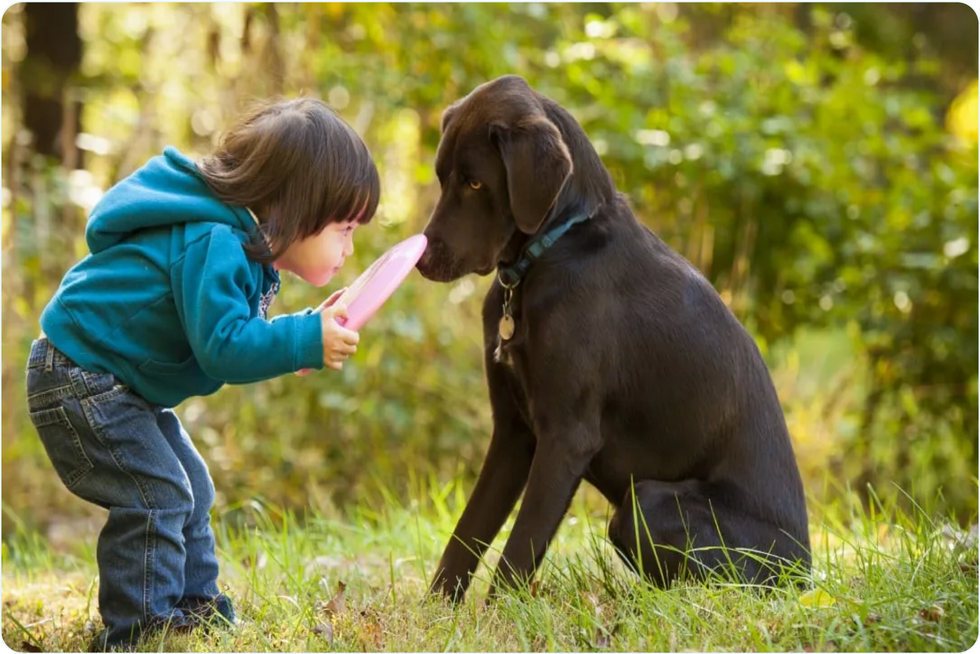
Chapter Three explores the unique bond between pets and neurodiverse children, highlighting how animals provide essential support and companionship.
Covering conditions like autism, attention deficit hyperactivity disorder (ADHD), and more, it discusses the specific benefits pets offer, such as reducing stress, improving social skills, and teaching responsibility.
This chapter also identifies the best pet types for each condition, explaining how their presence can positively impact a child's emotional and social development.
What Does Science Say?
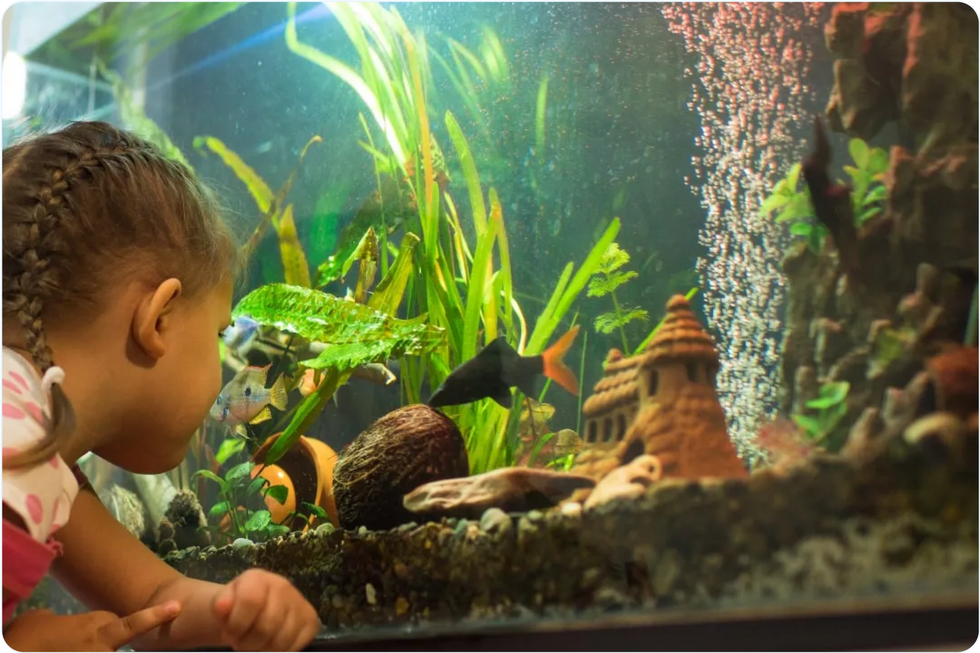
The National Institutes of Health, part of the U.S. The Department of Health and Human Services, has partnered with the Mars Corporation’s WALTHAM Center for Pet Nutrition for some years now. They fund research studies and large-scale surveys to answer questions such as, who benefits from an animal? And which type of pet brings health benefits?
As part of this, they have been studying animal interactions with autistic kids and kids who have ADHD and other conditions. The findings, reported in the research article The Power of Pets and discussed below, are interesting.
“We’re trying to tap into the subjective quality of the relationship with the animal—that part of the bond that people feel with animals—and how that translates into some of the health benefits,” explains Dr. James Griffin, a child development expert at NIH.
Animals can become a way of building a bridge for those social interactions"
Dr. James Griffin
Child development expert at NIH
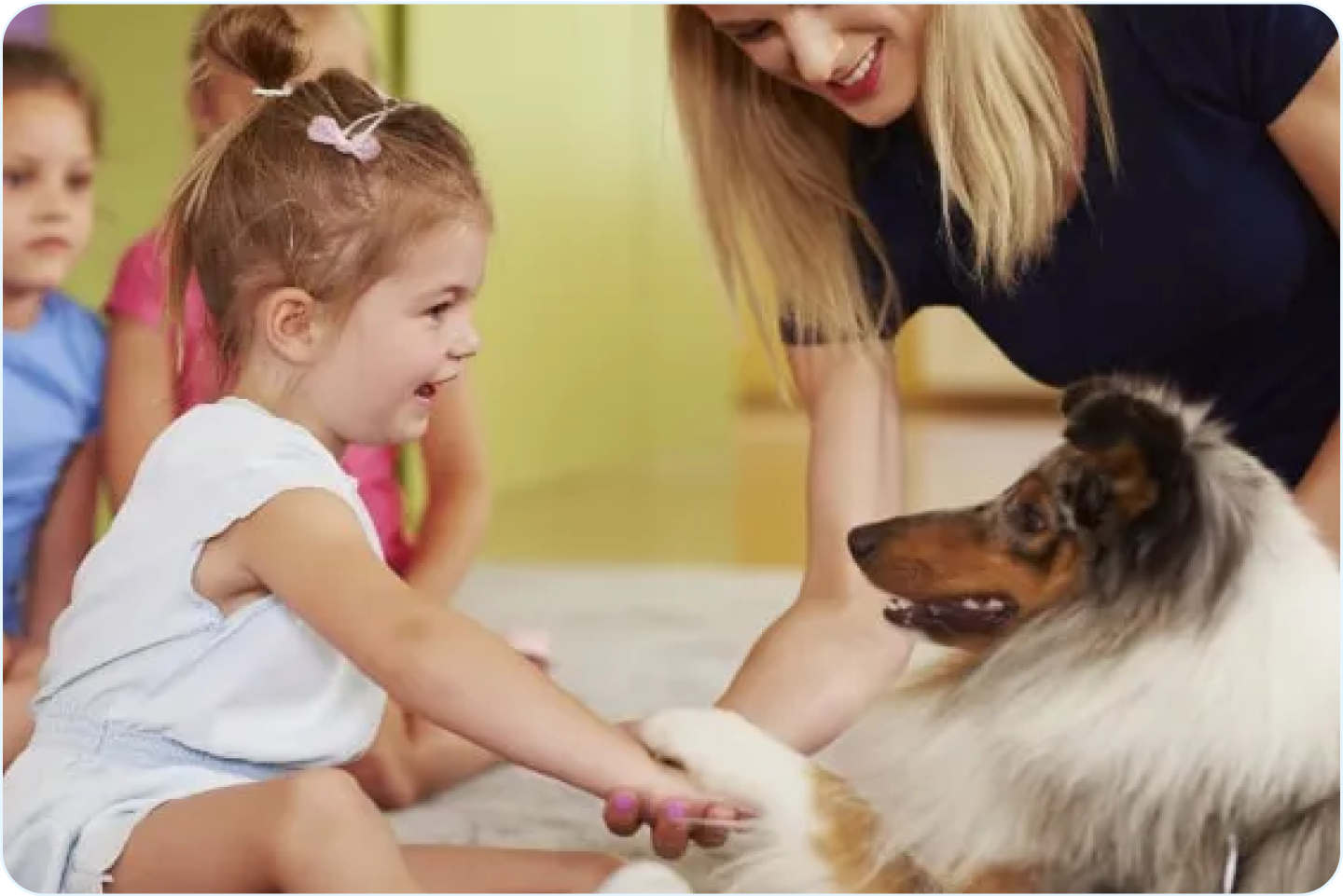
Benefits Of Pets For Autistic Children
- Studies show that playing with pets, even for a short time, can make autistic children calmer and happier.
- Pets offer unconditional love and acceptance. This can improve a child's confidence and help them connect with others.
One study found that autistic children were calmer while playing with guinea pigs in the classroom, compared to playing with a toy. After spending 10 minutes in a supervised group play session, the anxiety levels of the autistic children dropped.
The research also revealed the children had better social interactions and were more engaged with their peers. They were more likely to engage in behaviors such as introducing themselves, asking for information, or responding to questions.
A study, published in the Journal of Pediatric Nursing, surveyed parents of autistic children about the children’s interactions with dogs. They found:
94%
of families that owned a dog said their child bonded strongly with the pet
7 in 10
parents (in families without dogs) said their child enjoyed interacting with dogs
Some organizations train dogs specifically to be pets or assistance animals for autistic people, such as Dogs for Autism, Autism Dogs and Support Dogs.
These dogs offer benefits beyond the typical facets of pet ownership, helping autistic people access locations that may be challenging, such as airports and shops. They can also be trained to use a range of techniques to help calm a child, such as:
- Licking the child to comfort them
- Apply weighted pressure by leaning on the child; this can be used as a calming and grounding technique
- Using their paws and body to block the child from injuring themselves
Benefits Of Pets For Children With ADHD
- Dogs help children with ADHD pay attention. Some studies show that reading to therapy dogs improves focus and social skills.
- Pets need routines with feeding, walks, and bedtime. Participating in this responsibility can help a child with ADHD learn how to stay organized and stick to a schedule.
- Caring for pets brings kids into the present. This has a relaxing effect, which is good for everyone!
NIH has also reported on studies about how animals may help children with ADHD – in particular, how dogs can help them focus their attention. When researchers enrolled two groups of children diagnosed with ADHD into 12-week group therapy sessions, the first group read to a therapy dog once a week for 30 minutes. The second group read to puppets that looked like dogs.
Children who spent time reading to the real dogs had fewer behavioral problems during therapy, and they demonstrated better social skills – such as sharing more, cooperating, and volunteering.
A pet can also create structure and encourage regular habits, something which symptoms of ADHD may make tricky. Animals need consistency in terms of when they are fed, when they are exercised, and when they go to bed. Getting kids involved in this routine can help them thrive.
Beyond autism and ADHD, pets also offer tons of benefits for children with other neurodiverse conditions.
Benefits Of Pets For Children With Learning Disabilities
- Children with learning disabilities like dyslexia, dyscalculia, dysgraphia, and dyspraxia can benefit from having pets.
- Pets can help improve motivation, attention, and focus, which are some areas where children with learning disabilities often struggle.
- The companionship of pets can create a non-threatening learning environment, making children more comfortable and open to learning.
- Therapy animals can be particularly effective in educational settings, increasing children's motivation to learn and participate in activities.
Benefits Of Pets For Children With Sensory Processing Issues
- Pets can offer soothing sensory input for children with sensory processing issues, aiding in emotional regulation.
- Petting an animal can be calming for children who are over-responsive or under-responsive to sensory stimuli.
- Pets provide predictable and controllable sensory experiences, which are beneficial for children who experience sensory overload or seek sensory input.
Benefits Of Pets For Children With Mental Health Conditions
- Children with mental health conditions like anxiety, depression, and bipolar disorder can benefit from interactions with pets, experiencing reduced stress and improved mood.
- Pets provide emotional support, companionship, and a sense of security, aiding children facing emotional challenges.
- The presence of a pet can stimulate the release of feel-good hormones such as oxytocin and dopamine, enhancing a sense of well-being.
Benefits Of Pets For Children With Tourette Syndrome
- Pets, especially service dogs, can assist children with Tourette Syndrome by offering deep pressure therapy to reduce tic frequency and intensity.
- In social situations, they can serve as a buffer, reducing anxiety and stress that may worsen tics.
- Service dogs can be trained to recognize signs of an impending tic episode, providing distraction or intervention to help manage symptoms.
Which specific pets are best for neurodiverse kids?
Certain animals are known for their calming effects, and ability to provide consistent companionship and support in managing sensory challenges. By examining the unique bond between neurodiverse kids and their pets, this section reveals how certain animals can significantly improve their emotional and social development.
Pets For Autistic Children
- Dogs: Specifically, breeds like Golden Retrievers and Labrador Retrievers are known for their gentle nature and ability to provide emotional support and companionship. They can help reduce stress and anxiety and encourage social interaction.
- Cats: Cats can be independent yet affectionate companions that may provide comfort without the need for constant interaction, which can be suitable for some autistic children.
Pets For Children With ADHD
- Dogs: Breeds like Golden Retrievers and Labrador Retrievers can offer loyalty, and companionship, and help improve focus and responsibility. They also require physical activity, which can help children with ADHD burn off excess energy.
- Cats: Cats can be a great choice for children with ADHD who prefer a more independent pet. They can provide comfort and companionship without requiring constant attention.
- Fish: Watching fish swim can be fascinating and help children with ADHD relax, creating a calming environment and improving concentration.
- Small Rodents: Animals like hamsters or guinea pigs can provide hands-on interaction and improve focus and social skills. Caring for a small animal can also teach responsibility.
- Birds: Birds can be sociable and provide companionship, entertainment, and engagement. They can form strong bonds with their owners and create a calming environment that can improve concentration and reduce anxiety.
Pets For Children With Sensory Processing Disorders (SPD)
- Dogs: Breeds like Golden Retrievers, Labrador Retrievers, and Cavalier King Charles Spaniels are known for their calming presence and gentle demeanor, which can be beneficial for individuals with SPD
- Cats: For children with SPD, especially those who are hypersensitive, a calm and affectionate cat can provide a soothing presence without overwhelming sensory input
Pets For Children With Learning Disabilities
- Dogs and Cats: Dogs and cats can provide non-judgmental companionship and emotional support, which can be beneficial for children with learning disabilities.
Pets For Children With Tourette Syndrome
- Dogs: Service dogs trained to provide deep pressure therapy can help reduce the frequency and intensity of tics for children with Tourette syndrome. These dogs can also serve as a calming presence and help manage symptoms.
Pets For Children With Mental Health Conditions
- Dogs: Breeds like Golden Retrievers and Labrador Retrievers can provide emotional support and companionship, which can help reduce stress and improve mood.
- Cats: Affectionate cats can offer comfort and a sense of security for children dealing with emotional challenges.
- Small Pets: Animals like guinea pigs and rabbits can be therapeutic, offering comfort and helping to reduce anxiety levels.
Every child is unique. Different pets can help in different ways. A gentle cat, playful dog, or even calming fish can be a great fit depending on the child's needs.
Scientists are still studying the connection between neurodiverse kids and pets. There's a lot to discover about how animals can bring out the best in everyone!
Dr. Layla Esposito, who oversees NIH’s Human-Animal Interaction Research Program explains “there’s not one answer about how a pet can help somebody with a specific condition.” It depends on what you (and your family) are looking to gain from having a pet, as well as what type of home you can offer an animal.
Is your goal to increase physical activity? Then you might benefit from owning a dog. You have to walk a dog several times a day and you’re going to increase physical activity. If your goal is reducing stress, sometimes watching fish swim can result in a feeling of calmness. So there’s no one type that fits all."
Dr. Layla Esposito
NIH’s Human-Animal Interaction Research Program
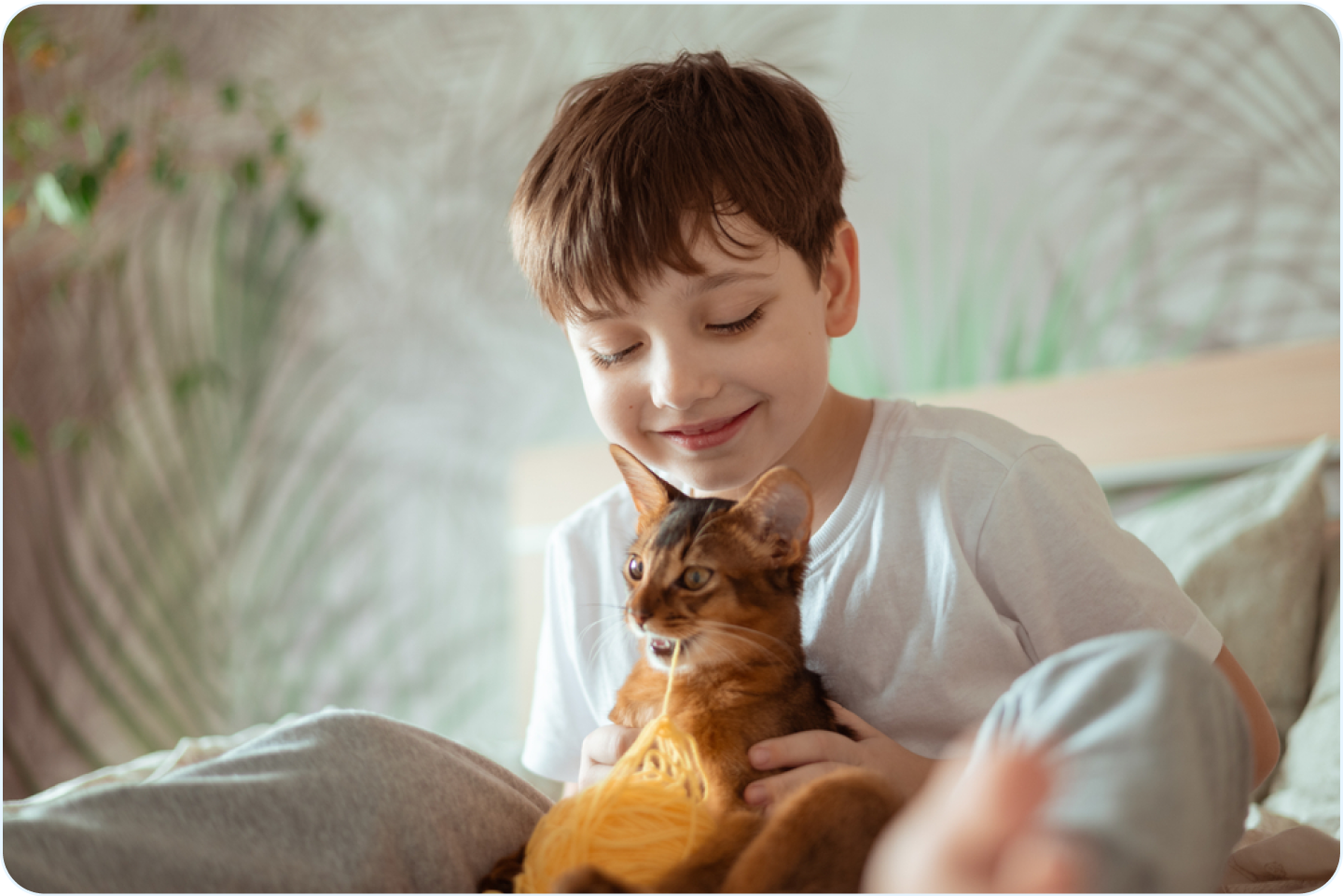
Chapter Four: Finding The Perfect Family Pet
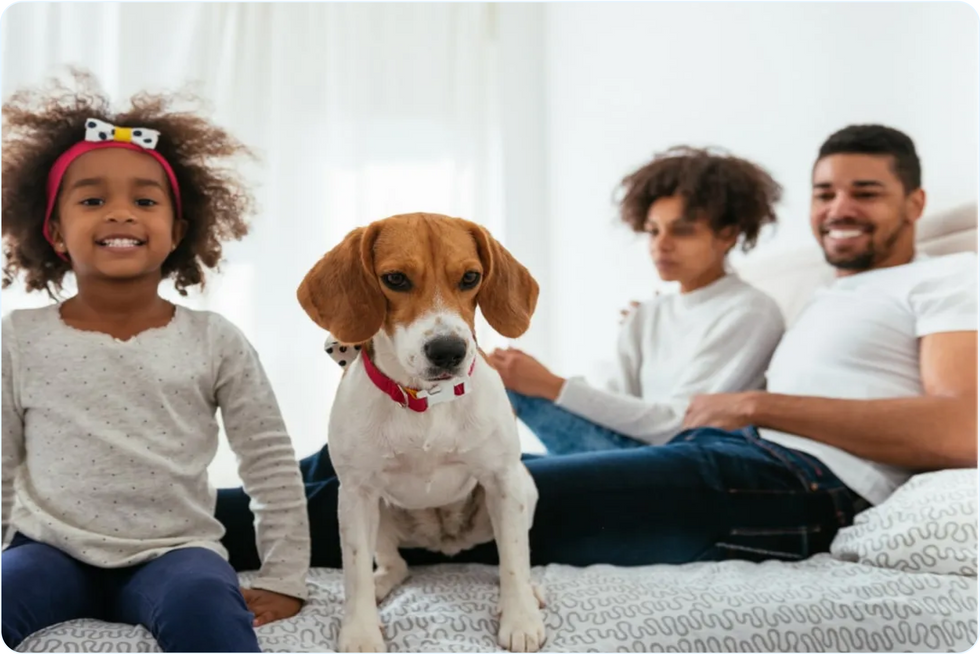
Welcoming a pet is a big decision. It brings joy and helps kids learn, but it's important to find the right fit for your family. The following are some tips to ensure your new animal companion has everything they need to thrive.
Know Your Pet's Needs
Different types of animals have different requirements for food, exercise, grooming, and space. Understanding these needs is important to providing appropriate care for your pet. These are the different categories.
Food
The dietary needs of animals vary greatly. Some animals, like cats, are obligate carnivores and require a diet primarily consisting of meat. They require certain nutrients that can only be obtained from animal-based proteins, such as taurine, arachidonic acid, vitamin A, and vitamin B12.
Others, like rabbits, are herbivores and need a diet rich in hay and vegetables. It's essential to provide your pet with a balanced diet that meets their specific nutritional requirements.
Exercise
Animals need regular exercise to stay healthy and happy. The amount of exercise required varies depending on the species.
Dogs, for example, are known for their high energy levels and need daily walks or runs. On the other hand, while cats may enjoy lounging, they require at least three five-minute intense play sessions each day, using activities like chasing toys, climbing cat trees, and interactive play with toys to ensure they get enough exercise.
Grooming
Grooming is an important aspect of animal care. Regular brushing helps remove dirt, loose hair, and parasites from the fur, keeping your pet clean and healthy. It also promotes good circulation and can help prevent skin problems.
Space
Animals need adequate space to move around and express their natural behaviors. The size of the enclosure or living area should be appropriate for the animal's size and activity level.
Providing your pet with sufficient space helps prevent boredom and allows them to engage in essential activities.
In general, you can expect the following specific needs depending on the kind of pet you’re interested in:

Dogs
- Daily food
- Daily exercise and mental stimulation
- Enough space and ideally a garden
- Regular grooming
- Vaccinations and vet check-ups

Cats
- Daily food
- Daily mental stimulation
- Regular grooming
- Litter trays, scratching posts and toys
- Vaccinations and vet check-ups

Fish
- A tank large enough for the fish
- Regular cleaning
- Daily food
- Toys such as floating rocks or decorative plants for stimulation
- Net for handling fish
- Regular water testing kit

Small animals (rabbits, guinea pigs, hamsters)
- A suitable spacious cage
- Regular cleaning
- Daily food
- Regular grooming
- Generally they thrive in the company of another small animal
- Vaccinations and vet check-ups
Questions To Ask Yourself

It’s likely you’ll have a favorite in mind, but you have to think about whether you’re the right owner for that animal. Can you meet its needs and offer it the right type of home and lifestyle? When thinking about getting a pet, start by asking yourself:
Do you have the time?
Examine your daily routine. Can you consistently dedicate time to pet care, including walking, playing, training, and providing attention?
Families are often busy, so think about how a pet would fit into your lifestyle, including whether you’d want to take the pet out with you where possible or if you’d be planning to leave them at home.
Dogs can be left at home for short periods but often enjoy a lot of attention, whereas a rabbit would be happy in the company of another of its kind.
You also have to think about the initial time investment in terms of familiarizing them with their new surroundings and any training you’ll need to do.
One of the biggest challenges pet owners talk about is the need to train pets or deal with any behavioral issues, identified by 45% of pet owners according to YouGov.
Do you have the budget?
Owning a pet can be costly, so it's important to evaluate if your budget can comfortably accommodate these expenses.
Consider the financial responsibilities associated with pet ownership. Consider expenses like food, vet visits, grooming, pet supplies, and potential emergencies.
You may also want to get pet insurance to cover emergencies and accidents and you can certainly consider all of the necessary pet supplies in your usual family budget.
Take the average annual expenses for dogs and cats, for example, as seen in the table below.
Do you have the space?
Your living situation must be suitable for the pet you wish to bring into your home. Pets need adequate space to move around, play, rest, and engage in their natural behaviors.
You might be surprised about how much stuff an animal needs. With children, you’ll likely already have a lot of toys and other extras. Similarly, it’s important to think about how different pets would fit in.
Do you have room for a fish tank the size you’d need? Do you have an area where a cat can retreat to as their own? A lot of animals need their own space to hide in – while it doesn’t have to be huge, it’s something to consider.
What’s more, you may need to be careful with where the pets who roam have access to or put in the time to train them. For example, some pet owners may choose to give their dog free rein downstairs, but not let them upstairs.

Source: National Pet Owners Survey by the American Pet Products Association (APPA) via Insurance Information Institute
Even once you’ve narrowed down an animal, there are different breeds to consider. Not every animal will behave the same or have similar needs. Take The American Kennel Club’s 2021 most popular dog breeds.
Poodles are likely to need far more grooming than some of the others, and while a Dachshund might take up less space in your home, you shouldn’t assume it needs less exercise simply because it’s smaller. You'll need to research the breeds to decide what will fit into your family lifestyle best.
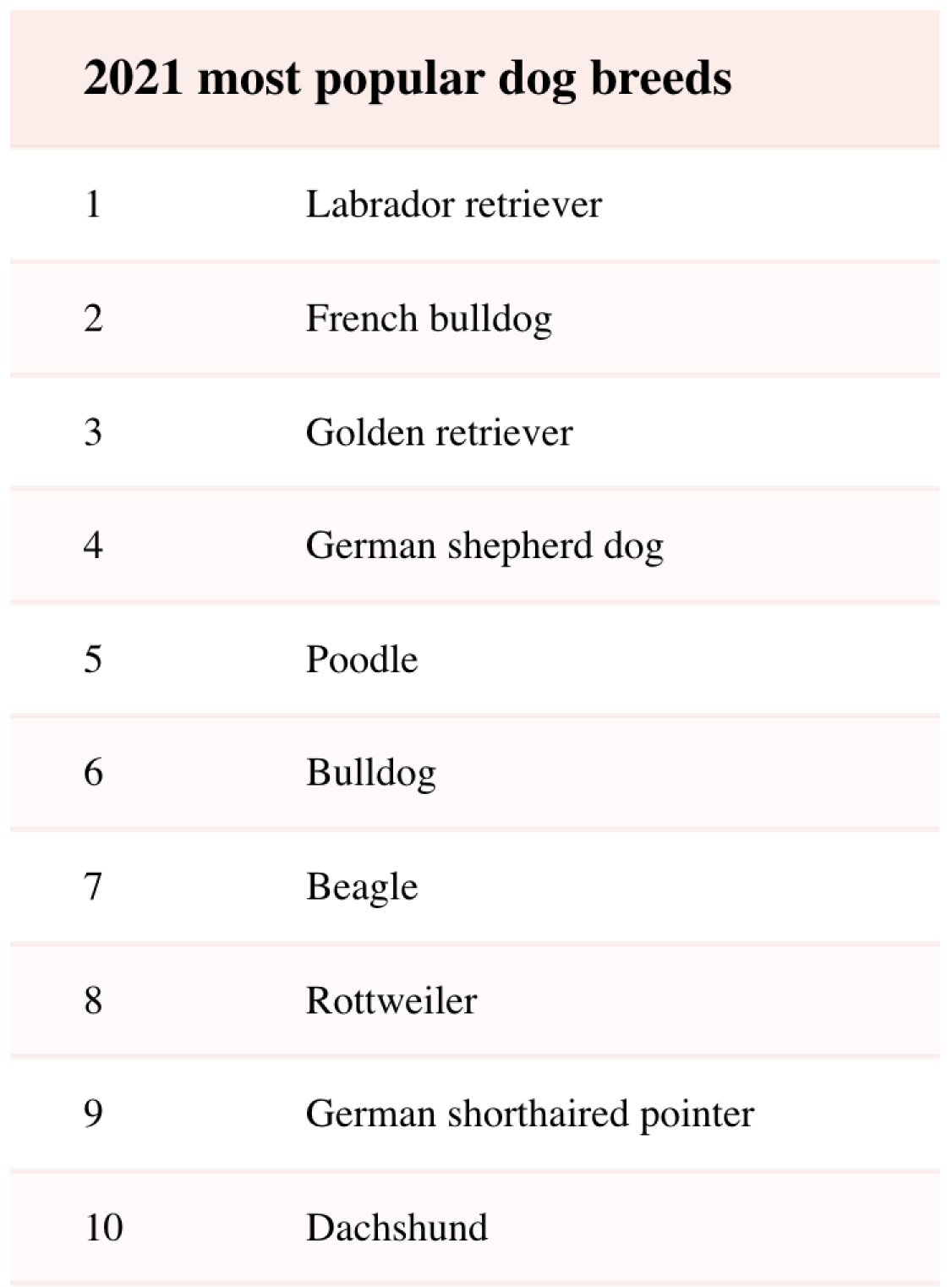
Other Ways To Enjoy Animals
If having a pet isn't the right fit for your family at this time, don't fret! There are plenty of ways to still enjoy the benefits of furry companionship. Here are a few ideas:
Visit Friends And Family With Pets
Spend time with your friends and family who have pets and enjoy the company of their furry friends. This is a great way to interact with pets without the commitment of having your own pet.
Go To Responsible Zoos Or Petting Farms
Visit zoos and petting farms that prioritize the well-being of their animals. This can be a fun and educational experience for both you and your family. You can observe different animals up close and learn more about their habitats and behaviors.
Observe Animals Safely In Nature
Take a walk in the park or go on a hike in the woods to observe animals in their natural habitats. This is a great way to appreciate the beauty and diversity of the animal kingdom. Just be sure to maintain a safe distance from wildlife and follow all safety guidelines.
These are just a few ideas for enjoying the company of animals without having a pet of your own. With a little creativity, you can find ways to incorporate animals into your life in a way that works for you and your family.
Encouraging Responsible Pet Ownership
One of the benefits of pet ownership for childhood development is the chance it gives children to take on new responsibilities.
While kids need to have fun and bond with their pets, they should also know and be involved in taking care of them. The best way to do that is by getting them involved in the daily tasks you’re responsible for.
Depending on their age, things you could teach your kids to do include:
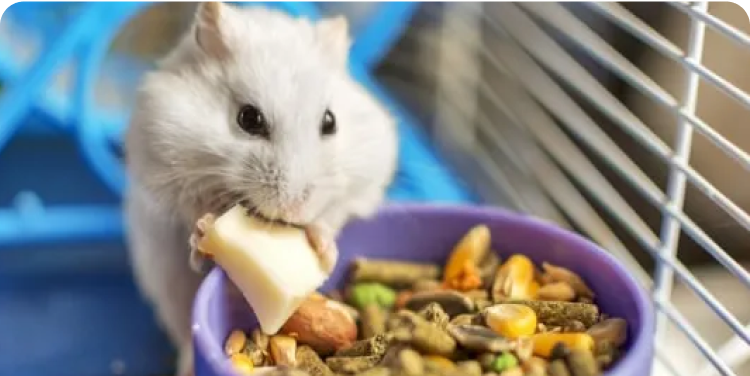
Feed
Most animals are fed daily. How much do you feed them? What do you feed them and why? These are all things you can explain to your child and start allowing them to take over.
You can emphasize the importance of routine for animals and encourage them to be responsible for keeping to a healthy schedule for your pet.
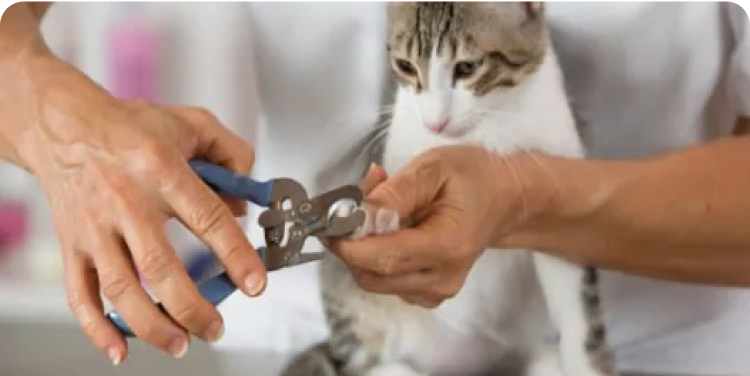
Grooming
Some animals will need grooming regularly. Not only does it keep their coats in good condition, grooming is also a chance to give your pets a bit of a once-over health check.
Look for any changes in the condition of their coat and run your hand over their bodies. Explain to your children that you’re simply looking for any changes, for example, a lack of shine in the coat, a lump under the skin or any scratches.
It introduces the idea of looking after their health regularly without it being a worrying moment.

Exercise
Dogs in particular do need daily exercise. Not only is a walk a good chance for a dog to run around, sniff new smells, and interact with other dogs, but it’s good exercise for their owners.
It’s something all the family can easily get involved in, and if pets don’t need exercise, they’ll likely still require some need of mental stimulation or attention.
A cat, for example, probably won’t go on a walk but you can make a conscious effort to engage with it daily, introducing new toys or a different game.
As a parent, you can decide when and how to get your children involved in the care of the family pets. It’s just important to encourage the behavior of responsible pet owners.
As a child matures, they can take on more of the daily jobs, boosting their sense of independence and responsibility.
After all, all of these activities lead back to the important role pet ownership plays in childhood development, animals large and small can teach, delight, and offer support while kids grow up.
Chapter 5: Useful Links

There Are Benefits Of Pet Ownership For The Whole Family: Especially Now
www.forbes.com
Selecting a pet for your family
www.avma.org
The Health and Mood-Boosting Benefits of Pets
www.helpguide.org
Emotional Benefits Of Pet Dogs For Kids
northstateparent.com
Guidelines for responsible pet ownership
www.avma.org
75 Ways to Be a Responsible Dog Owner
www.akc.org




